- Home
- Deborah Harkness
The World of All Souls Page 43
The World of All Souls Read online
Page 43
Lifestyles
All Souls Recipes
Diana’s Dinner for Matthew in New College
Nothing in my culinary experience had taught me what to feed a vampire when he came for dinner.
In my rooms I swept all the papers off a battered eighteenth-century table that served as both desk and dining room and moved it closer to the fireplace. I set the table carefully, using the old porcelain and silver that was in my cupboards, along with heavy crystal glasses that had to be the final remainders of an Edwardian set once used in the senior common room.
What do you make if a vampire is coming to dinner? While Matthew spent most of the day wondering what would happen later when he was alone with Diana (and if you are wondering what I thought might be going through his romantic brain during these long hours, listen to the Spill Canvas’s “The Night Will Go as Follows”—it will make you smile), Diana was shopping and worrying about what to feed this new friend of hers.
Dating a vampire would be a challenge. A huge challenge. Because food is a major way for warmbloods to share, get to know each other, and socialize. There had to be something for Diana and Matthew to share besides mutual passion, which is why there is such an emphasis on wine as something they can at least converse about over the dinner table.
But of course, as Matthew points out, he can and does eat. And bless Diana: She tried to come up with a vampire-appropriate meal—which meant I had to do so as well. All the recipes are on the web in one form or another, but this dish for rabbit and chestnut cakes struck me as a winner straightaway. It’s based on a traditional Tuscan dish. Olives and garlic are optional if you’re serving it to vampires. I imagine it would be quite good with little butterflied Cornish game hens if you don’t want to go the rabbit route, or even some chicken pieces—though of course if you’re cooking poultry, be careful to cook it properly.
Matthew and Diana have a wonderful Rhône Syrah with this dish.
Rabbit and Chestnut Cakes
Serves 2
INGREDIENTS
Chestnut Cakes
2 ounces chestnut flour
1 teaspoon baking powder
Pinch of salt
Water
2 tablespoons olive oil, plus ⅓ cup extra
2 ounces pine nuts
2 ounces currants or raisins (optional)
Fresh rosemary
Coarsely ground black pepper
Rabbit
1 farmed rabbit, jointed
Salt and white pepper
2 tablespoons olive oil or unsalted butter
4 cloves garlic, crushed but not peeled
¾ cup green olives
1 stalk celery, chopped
2 sprigs rosemary
TO MAKE THE CHESTNUT CAKE
Preheat the oven to 475 degrees F/240 degrees C/Gas Mark 9.
Mix the chestnut flour, baking powder, and salt in a bowl. Add water to this dry mixture, bit by bit, stirring to avoid lumps but using enough to form the same consistency as pancake batter. Finally, stir in the oil into the batter.
Pour the batter into a baking dish, approximately 12 by 8 inches, lined with parchment paper. Evenly scatter the pine nuts, currants, and rosemary over it. Drizzle extra olive oil across the top and finally the pepper.
Bake until the dish is crisp and brown on the top, about 20 minutes. Be careful not to overbake or it will become very dry. When it is ready, leave it in the dish on or next to the oven, to keep the dish warm.
TO MAKE THE RABBIT
Remove the fatty tissue/offal from inside the rabbit. Make sure all the silverskin and sinew have been removed from the outside. Clean the rabbit, cutting the saddle into evenly sized pieces. Season each of these with salt and pepper.
Heat the oil in a frying pan, and then add half the meat to the pan.
When the pieces are nearly browned on all sides, add 2 cloves of the garlic, half the olives and celery, and one of the sprigs of rosemary to the pan. Keep turning it all to spread the flavors, being careful not to burn it. Transfer the seared rabbit and seasonings to a warm baking dish and repeat the process with the remaining rabbit pieces and seasoning ingredients.
Place the baking dish with all the rabbit pieces in the preheated oven and roast at 475 degrees F/240 degrees C/Gas Mark 9, 10–12 minutes. When ready, serve with the chestnut cake.
(This recipe was adapted from www.sbs.com.au/food/recipes/rabbit-chestnut-cake.)
Wine
Matthew surprised Diana with a bottle of 1811 Château Yquem, the famous comet vintage (now known as Château d’Yquem, but that name was not used in 1811), at their dinner. A bottle of this wine was sold in the summer of 2011 for approximately $123,000. Not your usual first-date bottle!
Matthew’s Dinner for Diana in All Souls College
A vast refectory table stood at the far side of the main room, with newspapers, books, and the assorted detritus of academic life neatly arranged at one end. . . . At the other end of the table, a soft linen cloth had been thrown over the wood, held down by the most gorgeous Georgian silver candlesticks I’d ever seen outside a museum. A full array of different-shaped wineglasses stood guard over simple white plates and more Georgian silver.
Menu
Starter: Fresh Atlantic oysters and a champagne (from 1961)
Salad, with a glass of Diana’s birthday wine: Salad of mixed greens, nuts, berries, and small bites of partridge taken from the grounds of the Old Lodge. Dressed with a champagne vinaigrette. (To make the salad dressing, whisk together 1 part champagne vinegar to 2 parts olive oil.)
Main Course: Veal stew over rice, with 1900 Château Margaux, considered by many to be the finest wine ever made.
Veal Stew, Normandy Style
Serves: 6
INGREDIENTS
1 tablespoon unsalted butter
1 tablespoon olive oil
2½ pounds veal stew meat cut into 2-inch cubes
Salt and freshly ground black pepper
1 medium onion, finely chopped
4 cloves garlic, smashed and finely chopped
2 ribs celery, finely chopped
1 tablespoon dry-rubbed or ground sage
2 tablespoons all-purpose flour
1½ cups best-quality fresh apple cider
2 Granny Smith apples, cored, and sliced (leave skins on)
1½ cups beef or veal stock
⅓ cup whole cream or crème fraîche
1 tablespoon finely chopped fresh sage, for garnish
DIRECTIONS
In a 5-quart Dutch oven or similar-size pot, melt the butter and oil over medium-high heat.
Season the veal generously on all sides with the salt and pepper. Working in batches, add the veal cubes to the sizzling oil in the bottom of the pot. Cook each batch, turning the cubes, until they’re lightly browned all over, about 3 minutes.
Once the last batch is ready, remove from the pot and reserve together nearby.
Reduce the heat to medium low. Add the onion, garlic, celery, sage, and a light sprinkle of salt and pepper. Cook for 5 minutes, or until tender.
Return the reserved veal and any juices to the pot. Add the flour to the meat and vegetables, stirring everything, and cook for 1 minute. Pour the cider into the pot, stirring up any brown bits from the bottom of the pot. Bring to a boil over high heat and allow the cider to reduce for about 5 minutes. Reduce the heat to medium low and add the apples and stock.
Cook, uncovered, at a gentle simmer, for about 1½ hours, stirring from time to time until the veal is very tender. Add the cream (be aware that other substitutes will curdle) and fresh sage at the end. Once added, briefly heat through and serve.
(This re
cipe was adapted from Holly Herrick’s website, www.hollyherrick.com.)
After Dinner
Nutty biscuits and old, old malmsey (1785)
Em’s Famous Vanilla Vampire Walnuts
In A Discovery of Witches, when Marcus bemoans the fact that he can no longer enjoy the taste of cookies, Em has the perfect substitute:
Serves: 16 warmbloods or 1 vampire
INGREDIENTS
2½ tablespoons vegetable oil (not olive oil—something flavorless, like sunflower or safflower oil)
1 tablespoon vanilla extract
1 pound shelled nuts (walnuts are traditional, though southern vampires may like some pecans, Spanish vampires like almonds, and a mixture is fine! Em doesn’t recommend cashews for this recipe as they are quick to burn.)
½ cup granulated sugar
¼ teaspoon salt
¼ teaspoon ground coriander
¼ teaspoon cinnamon
¼ teaspoon nutmeg
SPELL/METHOD
Preheat the oven to 325 degrees F/160 degrees C/Gas Mark 3.
Blend the oil with the vanilla extract.
Blanch the nuts for 1 minute in boiling water. Drain. While still hot, put them in a bowl with the oil/vanilla mixture and the sugar. Let stand for 10 minutes.
Arrange the nuts on a rimmed baking sheet. (Using one with a rim will keep your nuts from driving you nuts!) Bake for 30–35 minutes, turning and stirring them every 5–10 minutes until the nuts are brown and crispy. Watch for burning—they can go from brown to burned in 30 seconds. You may find you need to remove them at around the 20-minute mark if your oven runs hot. Be careful handling them as they will be very hot because of the sugar.
While the nuts are in the oven, combine the salt, coriander, cinnamon, and nutmeg in a large bowl. Tip the baked nuts into the bowl and toss with the spices. Spread in a single layer to cool (they will get crispier as they cool). Store in an airtight container.
These nuts are good for garnishing cakes and cupcakes, chopping up and putting on Sarah’s oatmeal, snacking, serving to vampires in lieu of cookies, and as a salad topping. Diana likes them in an arugula salad with goat cheese and some pomegranate seeds (seasonal colors!).
(This recipe was adapted for vampires from The Frog Commissary Cookbook by Steven Poses, Anne Clark, Becky Roller.)
All Souls Sixteenth-Century Dishes
Quince
Quinces, a knobbly, yellow pearlike fruit, were kept in bowls at the Old Lodge, where their pleasant scent perfumed the air. Diana used one of them to demonstrate her magic to Widow Beaton and the rest of the School of Night, holding the quince in the palm of her hand until the sunlight left the fruit, shriveling and softening it to pulp in moments.
Most sixteenth-century English gardens grew a quince tree, but because the fruit’s skin is tough and their flesh so astringent, very few quince varieties were eaten fresh. Their flesh is high in pectin, so they were most often peeled and added to cooked fruit to make jams, jellies, and puddings, to which they also lend their delicious scent. Quinces are an almost magical fruit—their flesh is sour and tough when raw but transforms into something absolutely exquisite when cooked.
Here is a modern recipe for quince:
Quince Jam
Makes enough to fill approximately 5 large jars.
INGREDIENTS
Approximately 2 pounds of quince (roughly 5 quince) to produce 6 cups (packed) of grated quince
4½ cups water
1 tablespoon lemon zest
¼ cup lemon juice
4 cups sugar
DIRECTIONS
Wash the fruit and grate the quince, along with the peel, leaving only the core remaining, until you have about 6 cups of grated quince.
Put the water in a large, heavy-bottomed pot (6- to 8-quart capacity) and bring to a boil. Add the grated quince, lemon zest, and lemon juice. Reduce the heat and simmer until the quince is tender, approximately 10 minutes.
Add the sugar and stir with a wooden spoon until dissolved. Bring it to a boil again, then reduce the heat to medium high. Cook uncovered for up to about 50 minutes, stirring intermittently, until the jam turns pink and thickens to the setting point. Keep checking as you stir to be sure that the jam does not burn on the bottom of the pan.
Once ready, ladle into sterilized canning jars and seal.
(This recipe was adapted from www.simplyrecipes.com/recipes/quince_jam.)
Comfits
When Henry Percy, Lord Northumberland, accompanied Matthew and Diana to Lady Mary Sidney’s house for Diana’s first visit, Mary served them comfits, to Henry’s great delight.
Comfits were delicious sweets intended to settle the stomach. In order to make comfits, a small seed or bit of peel was coated in a light sugar syrup. The candies were then swirled in a pan and rubbed by hand to separate them. They were coated repeatedly, perhaps a dozen times, then allowed to dry overnight, before undergoing the coating and drying processes a second time. Edible dyes such as mulberry juice, spinach, and saffron were often added to the final coat to produce colorful treats. Because the making of comfits was such a time-consuming and labor-intensive process, they were generally enjoyed only by wealthy families in Elizabethan England.
Goose
Geese were useful animals in sixteenth-century England. Henry Percy brought Matthew and Diana a plucked goose for their Christmas dinner at the Hart and Crown in London. Henry VIII had been the first to institute turkey at the Christmas feast in England, but roast goose would still have been the traditional festive dish for most people. Goose feathers were also used for feathering arrows and making quill pens, which Diana, Matthew, Philippe, and the entire School of Night used by the dozens.
“Chef’s Menu”: Banquet Dishes at Sept-Tours
Matthew and Diana were married for the third (and final) time outside the village church at Sept-Tours in December 1590. After a brief ceremony, the bride and groom and their guests repaired to the great hall to enjoy Chef’s wedding banquet, as well as music and dancing. During their wedding feast, Diana described the delicious hubbub thusly: “Matthew and I sat alone at the family table, while Philippe strolled about serving wine and making sure the children got their fair share of spit-roasted hare and cheese fritters.”
The word “fritter” comes from the French word friture, which means “frying” or “fried food.” A common comfort food, fritters were enjoyed by people of all classes across Europe on many occasions. Fritters are essentially a batter of flour and eggs, to which fruit, most commonly, apples, or root vegetables or cheese is added, as well as herbs and spices for seasoning. And if you were a person of means in Elizabeth’s England, you probably ate your fritters dusted or dipped in sugar, too.
Here’s a recipe for cheese fritters like those served at Matthew and Diana’s wedding. It is taken from Thomas Dawson’s manual for housewives, The Good Huswifes Jewell (published in 1585, 1596, and 1610), which contained medicines for ailments and recipes for the table.
To Make Curde Frittors
Take the yolks of ten Egs, and breake them in a pan, and put to them one handful Curdes and one handful of fine flower, and straine them all together, and make a batter, and if it be not thicke ynough, put more Curdes in it, and salt to it. Then set it on the fyre in a frying pan, with such stuffe as ye will frie them with, and when it is hot, with a ladle take part of your batter, and put of it into the panne, and let it run as smal as you can, and stir then with a sticke, and turne them with a scummer, and when they be fair and yellow fryed, take them out, and cast Sugar upon them, and serve them foorth.
Here’s a more modern version:
Curd Fritters
Serves: 1
INGREDIENTS
4 eggs
½ cup cheese curds (cott
age or ricotta cheese, strained to remove the excess whey)
½–¼ cup flour
Salt
1 tablespoon cooking oil or butter
Sugar (optional)
Nutmeg (optional)
DIRECTIONS
Beat the eggs, then add the cheese curds and slowly add the flour to make a very thin batter, then season with salt. Heat the oil in a frying pan, then pour in the batter, making sure it’s spread thinly, like crepe batter.
Fry each side of the fritter until lightly browned. Serve with the sugar and nutmeg sprinkled on top if you wish.
You can experiment with this recipe in the style of a sixteenth-century housewife by adding small amounts of chopped apples, beef, pork, spinach, and thinly sliced or grated root vegetables such as potatoes or beets to your fritter batter.
(This recipe was adapted from Plimoth Plantation’s Recipes, www.plimoth.org/learn/just-kids/recipes#curd.)
Elizabeth I’s Candied Violets
Sugar from sugarcane had long been produced in Asia but was relatively rare in Europe until the sixteenth century. Before then most Europeans used honey for sweetening foods. With the establishment of slave colonies and sugarcane plantations in the Caribbean and Brazil, sugar became increasingly available in Europe. During the reign of Queen Elizabeth I, the English, especially the nobility, developed an insatiable taste for sweets. Chefs used sugar to concoct “subtleties”—gigantic sugar sculptures that were anything but subtle, and sugar began to be used as a preservative, especially for fruits and flowers.

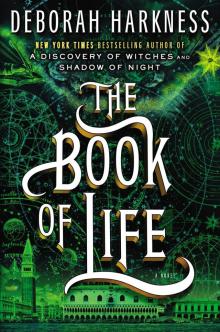 The Book of Life
The Book of Life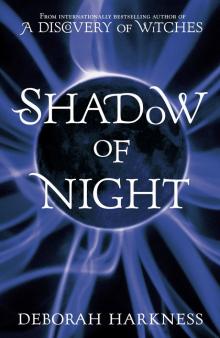 Shadow of Night
Shadow of Night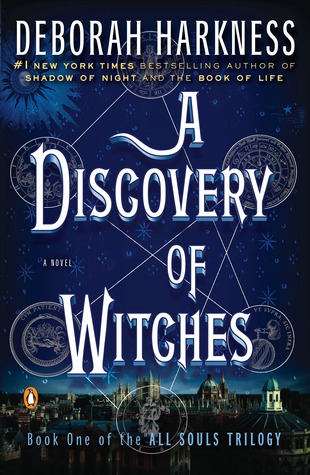 A Discovery of Witches
A Discovery of Witches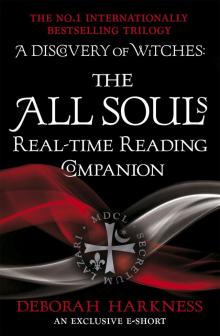 The All Souls Real-Time Reading Companion
The All Souls Real-Time Reading Companion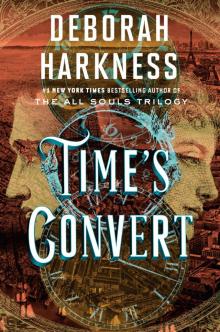 Time's Convert
Time's Convert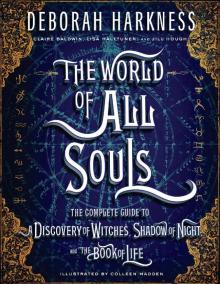 The World of All Souls
The World of All Souls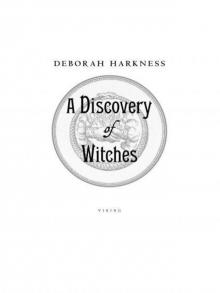 A Discovery of Witches: A Novel (All Souls Trilogy)
A Discovery of Witches: A Novel (All Souls Trilogy) Shadow of Night: A Novel
Shadow of Night: A Novel